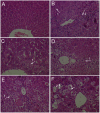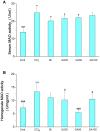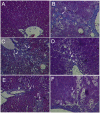The protective effect of glycyrrhetinic acid on carbon tetrachloride-induced chronic liver fibrosis in mice via upregulation of Nrf2
- PMID: 23341968
- PMCID: PMC3544925
- DOI: 10.1371/journal.pone.0053662
The protective effect of glycyrrhetinic acid on carbon tetrachloride-induced chronic liver fibrosis in mice via upregulation of Nrf2
Abstract
This study was designed to investigate the potentially protective effects of glycyrrhetinic acid (GA) and the role of transcription factor nuclear factor-erythroid 2(NF-E2)-related factor 2 (Nrf2) signaling in the regulation of Carbon Tetrachloride (CCl(4))-induced chronic liver fibrosis in mice. The potentially protective effects of GA on CCl(4)-induced chronic liver fibrosis in mice were depicted histologically and biochemically. Firstly, histopathological changes including regenerative nodules, inflammatory cell infiltration and fibrosis were induced by CCl(4).Then, CCl(4) administration caused a marked increase in the levels of serum aminotransferases (GOT, GPT), serum monoamine oxidase (MAO) and lipid peroxidation (MDA) as well as MAO in the mice liver homogenates. Also, decreased nuclear Nrf2 expression, mRNA levels of its target genes such as superoxide dismutase 3 (SOD3), catalase (CAT), glutathione peroxidase 2 (GPX2), and activity of cellular antioxidant enzymes were found after CCl(4) exposure. All of these phenotypes were markedly reversed by the treatment of the mice with GA. In addition, GA exhibited the antioxidant effects in vitro by on FeCl(2)-ascorbate induced lipid peroxidation in mouse liver homogenates, and on DPPH scavenging activity. Taken together, these results suggested that GA can protect the liver from oxidative stress in mice, presumably through activating the nuclear translocation of Nrf2, enhancing the expression of its target genes and increasing the activity of the antioxidant enzymes. Therefore, GA may be an effective hepatoprotective agent and viable candidate for treating liver fibrosis and other oxidative stress-related diseases.
Conflict of interest statement
Figures












Similar articles
-
The protective effect of hyperoside on carbon tetrachloride-induced chronic liver fibrosis in mice via upregulation of Nrf2.Exp Toxicol Pathol. 2017 Sep 5;69(7):451-460. doi: 10.1016/j.etp.2017.04.001. Epub 2017 Apr 20. Exp Toxicol Pathol. 2017. PMID: 28434817
-
In vitro and in vivo antioxidative and hepatoprotective activity of aqueous extract of Cortex Dictamni.World J Gastroenterol. 2017 Apr 28;23(16):2912-2927. doi: 10.3748/wjg.v23.i16.2912. World J Gastroenterol. 2017. PMID: 28522909 Free PMC article.
-
Hepatoprotective effects of 18beta-glycyrrhetinic acid on carbon tetrachloride-induced liver injury: inhibition of cytochrome P450 2E1 expression.Pharmacol Res. 2002 Sep;46(3):221-7. doi: 10.1016/s1043-6618(02)00121-4. Pharmacol Res. 2002. PMID: 12220964
-
Chlorella vulgaris extract ameliorates carbon tetrachloride-induced acute hepatic injury in mice.Exp Toxicol Pathol. 2013 Jan;65(1-2):73-80. doi: 10.1016/j.etp.2011.06.003. Epub 2011 Jul 8. Exp Toxicol Pathol. 2013. PMID: 21741806
-
Methotrexate hepatotoxicity is associated with oxidative stress, and down-regulation of PPARγ and Nrf2: Protective effect of 18β-Glycyrrhetinic acid.Chem Biol Interact. 2017 May 25;270:59-72. doi: 10.1016/j.cbi.2017.04.009. Epub 2017 Apr 13. Chem Biol Interact. 2017. PMID: 28414158
Cited by
-
Procyanidin A1 Alleviates Inflammatory Response induced by LPS through NF-κB, MAPK, and Nrf2/HO-1 Pathways in RAW264.7 cells.Sci Rep. 2019 Oct 21;9(1):15087. doi: 10.1038/s41598-019-51614-x. Sci Rep. 2019. PMID: 31636354 Free PMC article.
-
Fish Meal Replacement by Mixed Plant Protein in the Diets for Juvenile Yellow Catfish Pelteobagrus fulvidraco: Effects on Growth Performance and Health Status.Aquac Nutr. 2022 Nov 22;2022:2677885. doi: 10.1155/2022/2677885. eCollection 2022. Aquac Nutr. 2022. PMID: 36860441 Free PMC article.
-
Preparation and Characterization of Silymarin-Conjugated Gold Nanoparticles with Enhanced Anti-Fibrotic Therapeutic Effects against Hepatic Fibrosis in Rats: Role of MicroRNAs as Molecular Targets.Biomedicines. 2021 Nov 25;9(12):1767. doi: 10.3390/biomedicines9121767. Biomedicines. 2021. PMID: 34944582 Free PMC article.
-
Gallic and glycyrrhetinic acids prevent azithromycin-induced liver damage in rats by mitigating oxidative stress and inflammation.Sci Rep. 2025 Mar 20;15(1):9566. doi: 10.1038/s41598-025-93120-3. Sci Rep. 2025. PMID: 40113827 Free PMC article.
-
Nrf2 in liver toxicology.Arch Pharm Res. 2020 Mar;43(3):337-349. doi: 10.1007/s12272-019-01192-3. Epub 2019 Nov 28. Arch Pharm Res. 2020. PMID: 31782059 Free PMC article. Review.
References
-
- Kim HK, Li L, Lee HS, Park MO, Bilehal D, et al. (2009) Protective effects of Chlorella vulgaris Extract on carbon tetrachloride-induced acute liver injury in mice. Food Sci Biotechnol 18: 1186–1192.
-
- Guyton AC, Hall JE (2006) The liver as an organ. In: Guyton AC, Hall JE editors. Textbook of Medical Physiology. 11th ed. Philadelphia: Saunders Elsevier. 859–864.
-
- Friedman SL (2003) Hepatic fibrosis. In: Schiff ER, Sorrell MF, Maddrey WC editors. Schiff’s Diseases of the Liver. 9th ed. Philadelphia: Lippinocott Williams & Wilkins. 409–427.
-
- Poli G (2000) Pathogenesis of liverfibrosis: role of oxidative stress. Mol Aspects Med 21: 49–98. - PubMed
-
- Ivanov AV, Smirnova OA, Ivanova ON, Masalova OV, Kochetkov SN, et al. (2011) Hepatitis C Virus Proteins Activate NRF2/ARE Pathway by Distinct ROS Dependent and Independent Mechanisms in HUH7 Cells. PLoS ONE 6(9): e24957 doi:10.1371/journal.pone.0024957. - DOI - PMC - PubMed
Publication types
MeSH terms
Substances
LinkOut - more resources
Full Text Sources
Other Literature Sources
Medical
Miscellaneous

